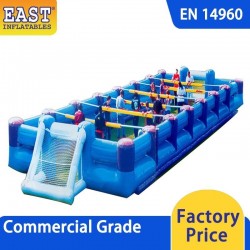
Packing inflatables for storage is essential to keep them in good condition and extend their lifespan. Whether you're storing inflatable toys, mattresses, boats, or other inflatable items, the following steps will help you do it properly:
Clean and Dry:
Before packing, make sure the inflatable is clean and dry. Remove any dirt, sand, or debris from its surface.
Inflate the item slightly to allow any trapped moisture to escape and wipe it down with a clean, dry cloth.
Deflate Completely:
Ensure the inflatable is fully deflated. Use the valve or air release mechanism to release all the air.
Carefully fold or roll the inflatable as tightly as possible to minimize the storage space needed.
Protect from Sharp Objects:
Inspect the storage area for any sharp objects that could puncture the inflatable, such as nails, screws, or sharp tools.
Place a protective barrier on the storage surface, like a tarp or foam padding, to prevent accidental damage.
Use a Storage Bag or Container:
If your inflatable item came with a storage bag or container, use it. This will help protect the inflatable from dust and potential punctures.
If no storage bag is available, consider using a large, clean plastic bag or plastic wrap.
Avoid Folding Creases:
When folding the inflatable, try to avoid creating creases or sharp bends. Over time, creases can weaken the material.
If possible, roll the inflatable rather than fold it to minimize creases.
Store in a Cool, Dry Place:
Store the inflatable in a cool, dry location away from direct sunlight, extreme temperatures, and humidity. Fluctuations in temperature and humidity can damage the material.
If you have a climate-controlled storage area, that's even better.
Protect from UV Exposure:
If you must store the inflatable in an outdoor area, cover it with a UV-resistant tarp or a specially designed inflatable cover to shield it from the sun's harmful rays.
Check Periodically:
Periodically check the inflatable during storage to ensure it remains in good condition. Look for signs of damage, leaks, or pests.
Properly Store Accessories:
If your inflatable has accessories like pumps, paddles, or repair kits, store them with the inflatable in a designated compartment or container. This makes it easier to locate everything when you want to use it again.
Consider Inflation:
Some inflatables benefit from being partially inflated during storage to help maintain their shape. However, avoid overinflating, as this can strain the seams and valves.
By following these steps, you can help ensure that your inflatables stay in good condition and are ready for use when you need them. Proper storage can significantly extend the lifespan of your inflatable items.




Leave a Comment